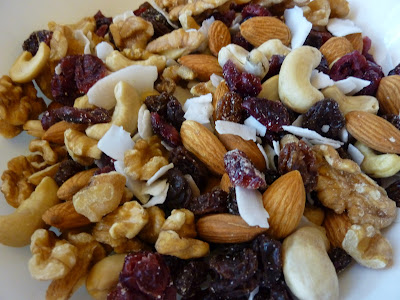 |
Excess calcium supplementation can have serious health consequences.
Follow Foods For Long Life on FACEBOOK . |
The Risk of Taking Too Much Calcium from Pills
I have often warned people about calcium supplementation.
* Not to take too many.
* Not to take them all at once.
* Not to take them without certain key complementary vitamins and minerals.
* To take the most absorbable form of calcium.
* To try to eliminate things that deplete the body's calcium.
* To get the calcium you need from food other than dairy.
I want to revisit this topic because of an important study that was published last month (May, 2012) by Li et al in the journal, Heart. This study looked at nearly 24,000 men and women ages 35-64 who had never had health issues with their heart. The study found that those participants who took calcium supplements over an 11 year period were 139% more likely to have a heart attack compared to those who did not use any supplements. Those participants who took supplements that provided calcium plus other vitamins and minerals had an 86% higher incidence of heart attacks. They did not, however, record the amount of calcium that the participants took. (That would have been useful!)
These numbers are shocking but when you think about it, perhaps it shouldn't surprise us. After all, isn't hardening of the arteries from their calcification? So when you take 1,000 mg of calcium all at once (and many people do that so they won't forget to take it), your body can't possibly process it. When calcium is introduced to the body in the form of food, it takes it in more gradually. If you ate a cup of cooked turnip greens, you'd get almost 200 mg of calcium, but your body would process it more slowly so it most likely wouldn't end up in your arteries! Researchers Reid and Bolland speculate that the excessive calcium from taking too many supplements at once "drives the antherogenic process" (the process that causes atherosclerosis).
Calcium Myth's
There is so much misinformation about calcium that it is no surprise that people are either getting too much of the wrong kind or not enough. Unfortunately most of the information we get is from the companies that are pushing their products (i.e. the dairy industry or the vitamin companies) or doctors , many of whom have had very little formal training in nutrition.
Myth # 1 - Everyone Needs a Ton of it
Although the Recommended Dietary Allowance (RDA) for many vitamins and minerals are too low, I feel that the RDA for calcium is much too high. (Could the dairy lobbyists have something to do with this?) From ages 9 to 18, boys and girls are told to get 1,300 mg per day and men from 19 to 70 years of age are to take 1,000 mg. Women are told to take 1,000 mg from 19 to 50 and then advised to increase it to 1,200 mg per day after age 70! I have always thought this was excessive and now I realize that it's also dangerous.
Calculating someone's daily requirements isn't that easy. There are so many things that effect your calcium needs. For example, if you don't do things that deplete calcium, you won't need as much.
There are many things that cause your body to deplete its calcium store. They include:
* Too much animal protein
When the body metabolizes animal protein, it produces acids as a byproduct. To remove these acids from the body, they must first be buffered with calcium. This calcium comes directly out of our bones. The more animal protein we eat, the more calcium is depleted from our bones. This does not happen when we eat plant protein.
* Too much salt
If you eat too much salt the body will excrete more calcium in the urine. Salt is found in most canned foods. Restaurants, including fast food establishments, heavily salt their foods.
* Too much phosphorus
The proper ratio of calcium to phosphorus is 1:1. If there is too much phosphorus, the parathyroid signals the release of calcium from the bones to balance out the phosphorus. The consumption of meat and processed foods containing chemical phosphates, especially soft drinks, causes a dangerous imbalance between these two important minerals.
* Too much sugar
Excessive sugar increases the urinary excretion of calcium and other minerals.
* Caffeine
Even modest amounts of caffeine can cause the loss of minerals from your bones.
* Too much alcohol
Alcohol can increase excretion of calcium and inhibit its absorption.
* Medications
Many medications, like antacids, antibiotics, etc., can effect calcium absorption and/or increase calcium excretion.
Myth # 2 - Dairy is the Best Source of Calcium
Another common belief is that dairy is the best source of calcium. As I mentioned above, the consumption and digestion of animal protein causes calcium loss so even if dairy contains large amounts of calcium, it also causes the excretion of large amounts of calcium.
The most eye-opening chart from T. Colin Campbell's book, The China Study, shows that the countries that consume the greatest amounts of calcium from cow's milk ( the U.S., New Zealand, Sweden) have the highest rate of hip fractures. Conversely, the countries that have the lowest consumption of cow's milk (Hong Kong, Singapore), have the lowest rate of hip fractures.
The best sources of calcium are:
* green leafy vegetables like kale, turnip greens, dandelion greens, mustard greens and collards
(except for spinach which is high in oxalic acid that binds the calcium)
* broccoli, bok choy and okra
* blackstrap molasses
* soybeans,
* calcium-set tofu
* oranges
* sesame seeds and tahini
* chia seeds and flax seeds
* almonds and almond butter
* Brazil nuts
* dried figs
* dried herbs like savory, celery seed, thyme, dill, etc.
 |
| Greens are a great source of calcium |
Other Things to Consider
Besides diet, one of the most important things you can do to build strong bones is to exercise. And it's never to late to start! Studies have shown an increase of bone calcium in post-menopausal women who adopted an exercise regime of aerobic activity like walking, dance, etc, together with strength-training exercises.
What should I do?
So you can see that one size does not fit all. If you eat lots of animal food, heavily salt your food, drink tons of coffee, soda and alcohol and follow it up with a handful of anti-acids while sitting on the couch, you probably are losing bone and are depleting your body of calcium at a pretty good rate. If you and your doctor feel that you must supplement, here are a few guidelines that I live by:
* Take into account all the calcium you are consuming from food before you decide how much to supplement. This includes fortified orange juice, fortified cereals and bread and all of the high calcium foods listed above. Even the tap and mineral water you drink can contribute significant amounts of calcium per day. Add it up, you may be getting more than you think!
* Pick a supplement that is absorbable. I prefer calcium citrate and avoid calcium carbonate that requires stomach acid for absorption.
* If you take a calcium supplement, balance it out with magnesium. Experts suggest taking at least one half as much magnesium as calcium up to equal amounts.
* Make sure you are getting enough vitamin D.
* Divide your doses of calcium throughout the day so that you never exceed 250 mg of calcium per dose. Some set the limit higher than that but I don't feel comfortable taking that much, especially in light of this recent study.
* Get some exercise.
If on the other hand you have a plant-based diet, exercise, don't drink soda, coffee or too much alcohol, and aren't taking medications, you may not need to supplement much or at all.
I personally only take one 250 mg calcium supplement per day in the form of a calcium-magnesium combination. On days I drink fortified almond milk, I skip my supplement all together. Since a recent test showed my bone density to be normal for my age, I don't plan to raise it. I don't consume dairy products of any kind so the leafy greens must be doing the trick!
My Main Message
My message to you today is to be very careful about chugging down the calcium pills. And pay particular attention to how much is already in fortified foods. I've recently noticed that many non-dairy milks are heavily fortified with calcium. It's a bit unclear what RDA they are referring to when they state "provides 35% RDA" since the daily requirement changes with age and gender (1,000 mg to 1,300 mg). But a cup of non-dairy milk that provides 35% of the RDA could be providing 350 mg to 455 mg of calcium. And some fortified milks brag that they provide even more! These levels of fortification can be dangerous.
February 24, 2013 UPDATE
A 19 year study in Sweden on the Long term calcium intake and rates of all cause and cardiovascular mortality, BMJ 2013 showed an increased risk of death from all causes of death and cardiovascular disease, but not from stroke, for women who had a high intake of calcium, especially when it was from supplements.
* Women whose intake of calcium of 1,400 mg or more per day from their diet were 40% more likely to die compared to women whose intake was 600 mg to 1,000 mg per day.
* Their risk of death increased to 157% higher if, in addition, they were also taking a 500 mg calcium supplement.
































